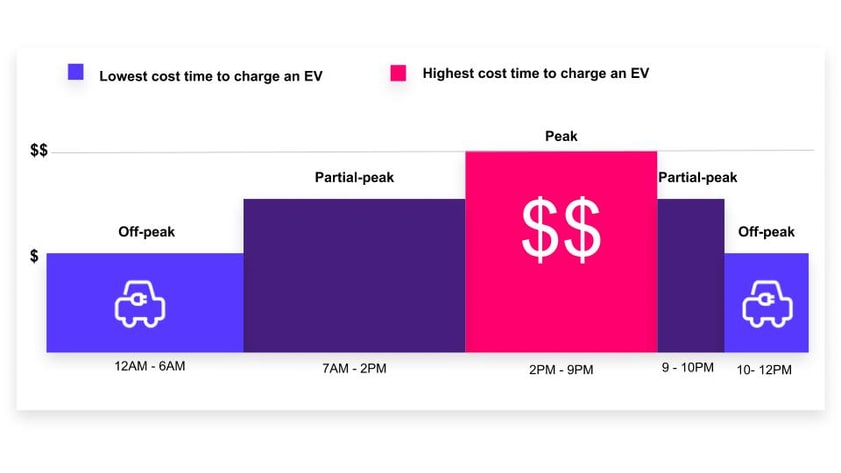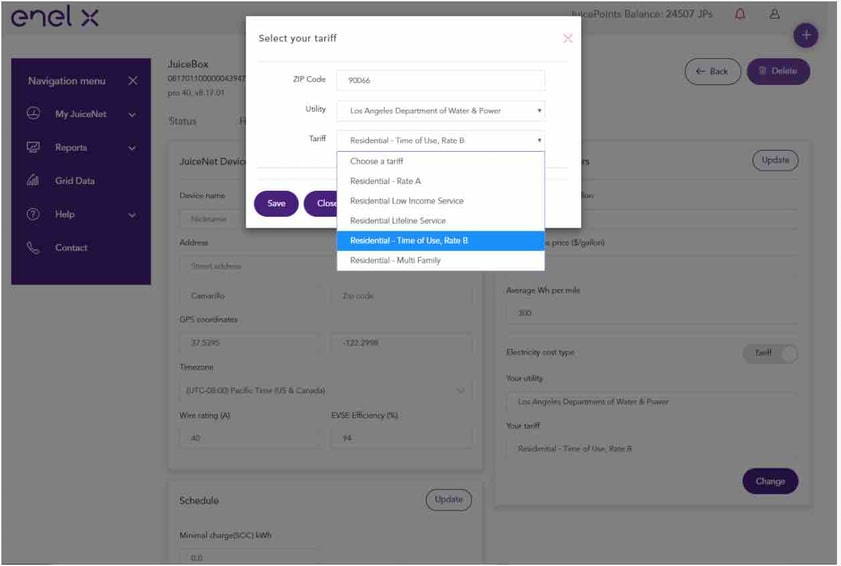Everything EV Drivers Should Know About Time-Of-Use Energy Rates

Across the country, utilities have started to introduce time-of-use (TOU) electricity rates – new rate structures that differ from a traditional flat rate, with the cost of energy use varying based on the day, time and season. Currently, about half of U.S. investor-owned utilities have optional TOU rates for their residential customers. However, these rates are being rolled out more aggressively in certain markets. For example, last year the California Public Utilities Commission made TOU rates mandatory for all utilities in the state. Pilot programs in markets like Colorado via Xcel Energy and Chicago via ComEd are also seeing traction, with utilities seeking to offer their customers more pricing options.
The general idea behind TOU rates is to incentivize customers to consume energy when the production cost is low or “off-peak,” and to disincentivize energy use when the cost of generating electricity is high, known as “on-peak.” The good news is that TOU rates give consumers more control over their energy savings than they may have previously had.
An understanding of how these rates are structured and implemented can help customers lower monthly utility bills, even for those who charge their electric vehicles at home on a regular basis.
How Do Time-Of-Use Rates Work?
TOU rates generally vary by several factors – time of day, day of week (weekday versus weekend) and time of year. Peak cost is typically at its highest in the late afternoon and evenings in the summer, while weekends, mornings and nights, are the lowest.
Similar variable pricing structures are familiar to customers in other forms, such as airline tickets. Most have had the experience of shifting travel plans by a day or two, or opting for an early morning flight or red-eye because the lower ticket price was more appealing. Similarly, a higher demand flight with an ideal departure day or time typically will cost more. In the same way, under TOU rates electricity is priced lower during off-peak hours, which more closely reflects the real cost to the utility rate as it is cheaper to produce at these times. For customers who can shift energy consumption activities to off-peak hours, like charging their electric car, doing laundry or running the air conditioner, the savings can be significant.
Electric Car Ownership and TOU Rates

Under TOU pricing, consumers should be able to easily check current rate structures by visiting their utility’s website, checking a recent bill or contacting the utility directly. Remember that pricing tends to change by season (with summer being most expensive), so it’s good to check prices for the entire year. Many utilities offering TOU rates also offer specific EV opt-in plans, which incentivize EV charging overnight with an even lower off-peak rate (sometimes offered via a credit).
Depending on when and how often an EV is driven, it’s likely that the majority of charging can be completed at home during off-peak hours, and is a great opportunity to save on energy cost. For JuiceBox owners, setting up a charging schedule in the JuiceNet app or online dashboard built around off-peak times is an easy way to ensure an EV is not actively charging when energy costs are at their highest, even if the car remains plugged in throughout the late afternoon or evening. If there is a need to charge during a peak period, tapping “Charge Now” at any time allows for immediate charging.
Additionally, JuicePoints and JuiceNet Green offer the ability to automatically maximize the use of renewable energy on the grid throughout the day, while JuicePoints enables customers to earn cash rewards.
One thing to note for residential customers who have a home solar system -- typically those already on net metering plans will not be eligible to sign up for an additional EV-specific rate as well. It’s best to check with the utility directly on specific rules and exclusions.
Consumer Response to Time-Of-Use Rates
Research has shown that utility customers respond positively to TOU structures, and actively shift their energy consumption to off-peak hours -- rather than plugging in when it’s most convenient.
Last year, Enel X partnered with the Smart Electric Power Alliance (SEPA) to survey 3,000 JuiceNet customers across 28 utilities offering EV specific rates on their charging patterns. Our study concluded that EV owners are particularly well-suited for time-varying rates, and 72% of non-enrolled TOU customers indicated that they were willing and able to charge their EV during off-peak hours if the standard rate resulted in bill savings and was convenient to use. Consumers have proven to be fairly price-sensitive when it comes to TOU rate structures, and it was found that for every 10% increase in peak to off-peak pricing, off-peak energy usage decreased by 6.5%.
EV ownership also often presents a customer’s first exposure to a TOU rate, underscoring the importance for utilities to create programs that ensure a transition to new EV-specific rates with minimal friction. Enel X’s survey concluded that TOU rates which are designed to save customers money, with limited barriers to entry and upfront costs, have potential to see participation rates roughly double that of other EV rate offerings. In fact, utility-driven initiatives to implement time-varying rates have proven to have a higher chance of success when compared to those which are mandated by regulators. Time of purchase is also a great opportunity for utilities to promote plans while consumers are actively engaged in the new EV ownership experience -- data shows that utilities that actively marketed EV rates are 1.4 times more likely to see opt-in participation.
Once they have enrolled, customers on a time-varying EV rate have proven to be more knowledgeable with their rate rules, and are more likely to charge at off-peak times.
TOU Rates and the Environment
TOU plan rates also provide an environmental benefit, as they tend to move customer energy use towards periods when lower-cost renewables are in greater supply, saving both utilities and customers money in the process. This also minimizes the need to spin up auxiliary power plants, many of which are powered by natural gas or coal. EV drivers who are conscious about the environmental impacts of energy production can also limit their public charging sessions to off-peak times, when renewable energy is more available on the grid.
EV sales are reaching an inflection point as battery prices continue to drop and more models are coming to market. Global sales topped 2 million in 2019, and IEA predicts there will be over 250 million electric vehicles on the road by 2030 -- and correspondingly demand for charging is set to skyrocket.
EV charging will increase peak energy demand, which will require grid upgrades in some places, particularly on the distribution grid. Problems are expected to occur as the EV fleet grows beyond 10% of all vehicles, according to BloombergNEF. Smart charging can convert EVs from grid liabilities to grid assets, mitigating upgrade costs in the process -- by some estimates between 30% and 70%, representing hundreds of millions, to potentially billions of dollars saved on a yearly basis. There is significant flexibility in the time of day that EV drivers charge and smart charging can reduce peak load by over 50%.
Utilities also stand to gain from the proliferation of EVs, incentivizing the implementation of intelligent charging solutions and beneficial time-varying rates now. Currently, revenues utilities are seeing as a result of increased charging are outpacing utility costs, as data from PG&E and Southern California Edison show. In California for example, grid upgrade costs due to EVs were just $17 per vehicle over the last six years, and this small per unit cost has enabled positive revenue growth for the utilities. Utilities stand to gain by educating customers on time-varying rates now and establishing strong customer relationships in the near-term, in order to build toward the transition to more actively managed charging in the future.
In the future, smart charging will become more dynamic and sophisticated, and there will be many strategies utilities use to influence or optimize charging behavior, including rate design (i.e. EV TOU rates) as well as other solutions such as demand response programs which leverage price signals for charging during the peak period. With effective smart charging strategies and a large EV fleet with flexible load, utilities can more effectively balance grids at all times of day resulting in lower electricity costs for all customers.



